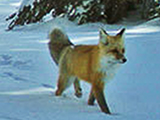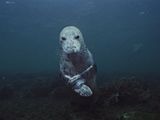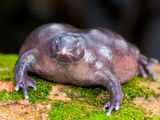Exclusive: Lost City Discovered in Honduran Rain Forest
In search for legendary “City of the Monkey God,” explorers find the untouched ruins of a vanished culture.

A “were-jaguar” effigy, likely representing a combination of a human and spirit animal, is part of a still-buried ceremonial seat, or metate, one of many artifacts discovered in a cache in ruins deep in the Honduran jungle.
PHOTOGRAPH BY DAVE YODER, NATIONAL GEOGRAPHIC
PUBLISHED MARCH 2, 2015
An expedition to Honduras has emerged from the jungle with dramatic news of the discovery of a mysterious culture's lost city, never before explored. The team was led to the remote, uninhabited region by long-standing rumors that it was the site of a storied "White City," also referred to in legend as the "City of the Monkey God."
Archaeologists surveyed and mapped extensive plazas, earthworks, mounds, and an earthen pyramid belonging to a culture that thrived a thousand years ago, and then vanished. The team, which returned from the site last Wednesday, also discovered a remarkable cache of stone sculptures that had lain untouched since the city was abandoned.
In contrast to the nearby Maya, this vanished culture has been scarcely studied and it remains virtually unknown. Archaeologists don't even have a name for it.

Honduran troops lead a convoy through a town that served as the base for helicopters ferrying members of the expedition to a location in the Mosquitia rain forest where they examined ruins of an ancient city.
PHOTOGRAPH BY DAVE YODER, NATIONAL GEOGRAPHIC
Christopher Fisher, a Mesoamerican archaeologist on the team from Colorado State University, said the pristine, unlooted condition of the site was "incredibly rare." He speculated that the cache, found at the base of the pyramid, may have been an offering.
"The undisturbed context is unique," Fisher said. "This is a powerful ritual display, to take wealth objects like this out of circulation."
The tops of 52 artifacts were peeking from the earth. Many more evidently lie below ground, with possible burials. They include stone ceremonial seats (called metates) and finely carved vessels decorated with snakes, zoomorphic figures, and vultures.
The most striking object emerging from the ground is the head of what Fisher speculated might be "a were-jaguar," possibly depicting a shaman in a transformed, spirit state. Alternatively, the artifact might be related to ritualized ball games that were a feature of pre-Columbian life in Mesoamerica.

A stream winds through part of an unexplored valley in Mosquitia in eastern Honduras, a region long rumored to contain a legendary “White City,” also called the City of the Monkey God.
PHOTOGRAPH BY DAVE YODER, NATIONAL GEOGRAPHIC
"The figure seems to be wearing a helmet," said Fisher. Team member Oscar Neil Cruz, head archaeologist at the Honduran Institute of Anthropology and History (IHAH), believes the artifacts date to A.D. 1000 to 1400.
The objects were documented but left unexcavated. To protect the site from looters, its location is not being revealed.

Former British Special Air Service (SAS) soldiers prepare a helicopter pilot for liftoff from a landing zone cleared for a team of scientists surveying a secret location in the Mosquitia jungle. The helicopter ferried people and supplies from its base.
PHOTOGRAPH BY DAVE YODER, NATIONAL GEOGRAPHIC
Stories of "Casa Blanca" and a Monkey God
The ruins were first identified in May 2012, during an aerial survey of a remote valley in La Mosquitia, a vast region of swamps, rivers, and mountains containing some of the last scientifically unexplored places on earth.
For a hundred years, explorers and prospectors told tales of the white ramparts of a lost city glimpsed above the jungle foliage. Indigenous stories speak of a "white house" or a "place of cacao" where Indians took refuge from Spanish conquistadores—a mystical, Eden-like paradise from which no one ever returned.
Since the 1920s, several expeditions had searched for the White City, or Ciudad Blanca. The eccentric explorer Theodore Morde mounted the most famous of these in 1940, under the aegis of the Museum of the American Indian (now part of the Smithsonian Institution).

Former British SAS soldier Andrew Wood hacks through thick foliage to clear a way for scientists to investigate an archaeological site first identified using an aerial imaging technology called lidar.
PHOTOGRAPH BY DAVE YODER, NATIONAL GEOGRAPHIC
Morde returned from Mosquitia with thousands of artifacts, claiming to have entered the City. According to Morde, the indigenous people there said it contained a giant, buried statue of a monkey god. He refused to divulge the location out of fear, he said, that the site would be looted. He later committed suicide and his site—if it existed at all—was never identified.
More recently, documentary filmmakers Steve Elkins and Bill Benensonlaunched a search for the lost city.
They identified a crater-shaped valley, encircled by steep mountains, as a possible location.

Archaeologist Oscar Neil Cruz of the Honduran Institute of Anthropology and History examines a building stone discovered during a foray to a location identified by lidar as a place of interest. Several such construction stones, apparently shaped by hand, were found in a row at the top of what appears to be an ancient plaza.
PHOTOGRAPH BY DAVE YODER, NATIONAL GEOGRAPHIC
To survey it, in 2012 they enlisted the help of the Center for Airborne Laser Mapping at the University of Houston. A Cessna Skymaster, carrying a million-dollar lidar scanner, flew over the valley, probing the jungle canopy with laser light. lidar—"Light Detection and Ranging"—is able to map the ground even through dense rain forest, delineating any archaeological features that might be present.

Frequent rains turned the expedition camp into a sea of mud.
PHOTOGRAPH BY DAVE YODER, NATIONAL GEOGRAPHIC
When the images were processed, they revealed unnatural features stretching for more than a mile through the valley. When Fisher analyzed the images, he found that the terrain along the river had been almost entirely reshaped by human hands.
The evidence of public and ceremonial architecture, giant earthworks and house mounds, possible irrigation canals and reservoirs, all led Fisher to conclude that the settlement was, indeed, a pre-Columbian city.

Former British SAS commando Steve “Sully” Sullivan (right) waits while the scientific team puzzles over a construction stone that they believe was carved by members of a vanished civilization yet to be identified.
PHOTOGRAPH BY DAVE YODER, NATIONAL GEOGRAPHIC
Threatened by Deforestation
An archaeological discovery isn't confirmed until it has been "ground-truthed." The ground exploration team consisted of American and Honduran archaeologists, a lidar engineer, an anthropologist, an ethnobotanist, documentary filmmakers, and support personnel. Sixteen Honduran Special Forces soldiers provided security. The National Geographic Society sent a photographer and a writer.
The expedition confirmed on the ground all the features seen in the lidar images, along with much more. It was indeed an ancient city. Archaeologists, however, no longer believe in the existence of a single "lost city," or Ciudad Blanca, as described in the legends. They believe Mosquitia harbors many such "lost cities," which taken together represent something far more important—a lost civilization.

Anna Cohen, a University of Washington anthropology graduate student, documents a cache of more than 50 artifacts discovered in the jungle. Following scientific protocol, no objects were removed from the site. The scientists hope to mount an expedition soon to further document and excavate the site before it can be found by looters.
PHOTOGRAPH BY DAVE YODER, NATIONAL GEOGRAPHIC
The valley is densely carpeted in a rain forest so primeval that the animals appear never to have seen humans before. An advance team clearing a landing zone for helicopters supplying the expedition noted spider monkeys peering down curiously from the trees above, and guinea hen and a tapir wandering into camp, unafraid of the human visitors.
"This is clearly the most undisturbed rain forest in Central America," said the expedition's ethnobotanist, Mark Plotkin, who spent 30 years in Amazonia. "The importance of this place can't be overestimated."
This is clearly the most undisturbed rain forest in Central America. The importance of this place can’t be overestimated.
The region also is gravely threatened. Deforestation for ranching has checkerboarded the jungle to within a dozen miles of the valley. Huge swaths of virgin rain forest are being cut illegally and burned to make way for cattle. The region has become one of the biggest beef-producing areas in Central America, supplying meat to fast-food franchises in the United States.
Virgilio Paredes Trapero, the director of the IHAH, under whose auspices the expedition operated, spent several days at the site. He concluded: "If we don't do something right away, most of this forest and valley will be gone in eight years." He spread his hands. "The Honduran government is committed to protecting this area, but doesn't have the money. We urgently need international support."

In addition to looting, another threat to the newly discovered ruins is deforestation for cattle ranching, seen here on a hillside on the way to the site. At its present pace, deforestation could reach the valley within a few years.
PHOTOGRAPH BY DAVE YODER, NATIONAL GEOGRAPHIC
The expedition was made possible with the permission, partnership, and support of the government of Honduras; Honduran President Juan Orlando Hernández Avarado; Virgilio Paredes Trapero, director of the Honduran Institute for Anthropology and History (IHAH); Oscar Neil Cruz, Chief of the Archaeology Division of IHAH, as well as Minister of Defense Samuel Reyes and the Armed Forces of Honduras under the command of Gen. Fredy Santiago Díaz Zelaya, with Gen. Carlos Roberto Puerto and Lt. Col. Guillermo Oseguera, and the soldiers of TESON, Honduran Special Forces.
Douglas Preston writes about archaeology for the New Yorker and other publications. His account of Coronado's search for the Seven Cities of Gold was recently issued as an e-book.















No comments:
Post a Comment
Please leave a comment-- or suggestions, particularly of topics and places you'd like to see covered